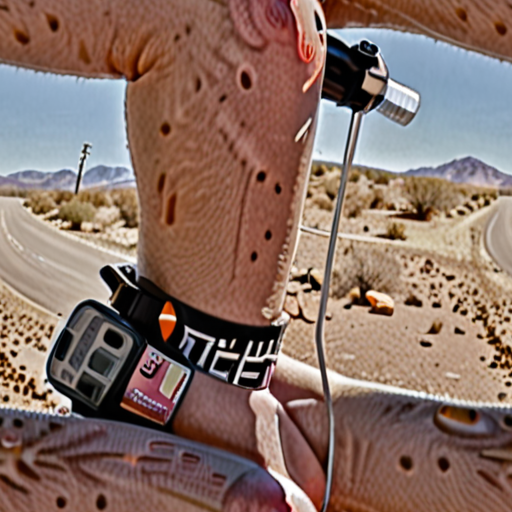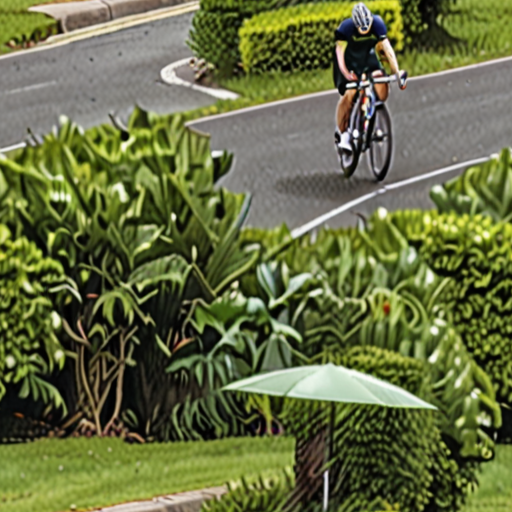“`html
In this scorching summer, navigating the balance between staying active and prioritizing your safety becomes essential, especially when it comes to cycling in hot weather. Many cyclists wonder, “Is it okay to bike in hot weather?” or “What temperature is too hot to cycle?” In this article, we’ll delve into the science behind the heat index and understand its impact on cyclists. We’ll explore the crucial factors that determine safe cycling temperatures, including your age, physical condition, and the type of gear you use. Discover the “75 Rule” in cycling and how it can guide you to optimize your routines without jeopardizing your health. Whether it’s a sweltering 95-degree day or an unusually humid summer, we’ll provide you with tips to stay cool, hydrated, and safe. From choosing the right attire to adapting your cycling schedule, this article equips you with the guidelines needed to enjoy cycling in the heat responsibly, not just in places like California, but worldwide.
“`
What Temperature Is Too Hot To Cycle?
Cycling in hot weather can be challenging, and it’s essential to know when the temperature becomes too hot to ride safely.
- The general consensus among cyclists is that temperatures above 40°C (104°F) can lead to heat-related illnesses, including heat exhaustion and heat stroke.
- At temperatures between 35°C (95°F) and 40°C (104°F), cyclists may start to feel the effects of heat stress, such as dizziness, nausea, and fatigue.
- When the temperature reaches 38°C (100°F), cyclists may begin to experience dehydration, headaches, and muscle cramps.
It’s worth noting that individual tolerance to heat varies greatly, and some people may be more susceptible to heat-related illnesses than others.
As a cyclist, it’s crucial to take necessary precautions when riding in hot weather, such as staying hydrated, wearing light and breathable clothing, and taking regular breaks in shaded areas.
Additionally, consider avoiding peak sun hours (usually between 11 am and 3 pm) and opt for early morning or late afternoon rides when possible.
Remember, safety always comes first, and it’s better to err on the side of caution when it comes to cycling in extreme heat.
For more information on how to stay safe while cycling in hot weather, check out our guide on cycling safety tips .
Stay cool and keep pedaling!
Is it Okay to Bike in Hot Weather?
Cycling in hot weather can be challenging, but with proper precautions and knowledge, it can be safe and enjoyable.
- Stay Hydrated
- Dress Appropriately
- Ride During Cooler Hours
- Monitor Your Body Temperature
- Be Aware of Heat-Related Illnesses
Drinking plenty of water before, during, and after your ride is crucial to prevent dehydration. Aim to drink at least 8-10 glasses of water per day, and consider bringing a hydration pack or water bottle with you on your ride.
Wearing lightweight, light-colored clothing made of breathable fabrics can help keep you cool. Consider wearing a hat or visor to protect yourself from the sun, and don’t forget to apply sunscreen with a high SPF rating.
Avoid riding during the hottest part of the day (usually between 11am and 3pm). Instead, try to schedule your rides early in the morning or late in the evening when the temperature is cooler.
Pay attention to how your body is feeling, and take regular breaks to rest and hydrate. If you start to feel overheated, dizzy, or nauseous, stop and seek shade immediately.
Heat exhaustion and heat stroke are serious medical conditions that can occur when the body is unable to cool itself properly. Know the symptoms and take immediate action if you or someone you’re riding with experiences them.
By taking these precautions and staying informed, you can enjoy cycling in hot weather while minimizing your risk of heat-related illnesses.
Tips for Cycling in Extreme Heat:
- Take regular breaks to rest and hydrate
- Choose routes with shaded areas or tree cover
- Avoid riding during peak sun hours
- Wear lightweight, light-colored clothing
- Bring a hydration pack or water bottle
Staying Safe While Cycling in Hot Weather:
- Know the signs of heat exhaustion and heat stroke
- Monitor your body temperature regularly
- Seek shade immediately if you start to feel overheated
- Drink plenty of water before, during, and after your ride
- Consider riding with a buddy or group

The 75 Rule in Cycling
In order to increase your cycling wattage, it’s best to follow the 75 percent rule, which states that throughout the week, 75 percent of your cycle training should be done below 75 percent of your maximum heart rate (MHR).
- This training principle helps to improve cardiovascular fitness and increase endurance.
- By incorporating interval training into your routine, you can boost your power output and efficiency on the bike.
- For example, you could spend 75 percent of your ride at a moderate intensity, with the remaining 25 percent dedicated to high-intensity intervals.
When implementing the 75 rule, consider the following:
- Warm-up and cool-down periods should be included in your ride to prevent injury and promote recovery.
- Aim to incorporate strength training exercises two to three times per week to complement your cycling routine.
- Make sure to listen to your body and adjust your training plan accordingly – rest days are essential for allowing your muscles to recover.
At Leeds Bicycle, we recommend consulting with a qualified coach or trainer to develop a personalized training plan tailored to your needs and goals.
Additionally, consider investing in a heart rate monitor or power meter to track your progress and optimize your training.
Remember to stay hydrated and fuel your body with a balanced diet to support your training regimen.
By following the 75 rule and incorporating these tips into your cycling routine, you’ll be well on your way to increasing your wattage and achieving your fitness goals.

Is 95 Degrees Too Hot to Ride a Bike?
Riding a bike can be an enjoyable activity, but extreme temperatures can pose a risk to your safety.
- When the temperature reaches 95 degrees Fahrenheit, it may be too hot to ride a bike safely.
- The heat index, which takes into account humidity and wind speed, can make the air feel even hotter.
Risks Associated with Riding in Extreme Heat
Riding a bike in extremely hot weather can lead to dehydration, heat exhaustion, and heat stroke.
- Dehydration occurs when the body loses more fluids than it takes in, causing an imbalance in electrolytes and water levels.
- Heat exhaustion is a condition that occurs when the body’s cooling systems are overloaded, leading to symptoms such as dizziness, nausea, and headaches.
- Heat stroke is a life-threatening condition that occurs when the body’s temperature regulation system fails, causing the body temperature to rise rapidly.
Precautions to Take When Riding in Hot Weather
To minimize the risks associated with riding in hot weather, take the following precautions:
- Stay hydrated by drinking plenty of water before, during, and after your ride.
- Wear lightweight, light-colored clothing that allows for good airflow and helps keep you cool.
- Avoid riding during the hottest part of the day, typically between 11am and 3pm.
- Take regular breaks to rest and rehydrate.
Alternatives to Riding in Extreme Heat
If the temperature is expected to reach 95 degrees or higher, consider alternative activities such as:
- Indoor cycling or spin classes.
- Swimming or other low-impact exercises.
- Walking or hiking in shaded areas.
Remember to always prioritize your safety and well-being when riding a bike in hot weather.
At What Temperature Should I Stop Riding My Bike?
Riding a bike in extreme cold weather can be uncomfortable and even hazardous.
- As a general rule, it’s recommended to stop riding your bike when the temperature drops below 32°F (0°C), as this is the freezing point of water.
- However, this can vary depending on individual factors such as wind chill, humidity, and personal comfort level.
For example, if you’re planning to ride in windy conditions, you may want to consider stopping at a lower temperature due to the increased risk of hypothermia.
- Additionally, if you’re riding in extremely humid conditions, you may feel colder than you would in dry conditions, even if the temperature is relatively mild.
- Ultimately, the decision to stop riding your bike in cold weather depends on your personal comfort level and ability to stay safe.
It’s always better to err on the side of caution and stop riding if you start to feel uncomfortable or experience any symptoms of hypothermia, such as shivering, numbness, or confusion.
Factors to Consider When Deciding Whether to Ride in Cold Weather:
- Wind Chill:
- Humidity:
- Personal Comfort Level:
- Riding Experience:
- Temperature:
Staying Safe While Riding in Cold Weather:
To minimize the risks associated with riding in cold weather, make sure to wear warm and breathable clothing, including a hat, gloves, and scarf.
Avoid riding in extremely cold or windy conditions, and take regular breaks to warm up and rehydrate.
Stay alert and aware of your surroundings, and be prepared to stop riding if you start to feel uncomfortable or experience any symptoms of hypothermia.

Is 95 Too Hot to Play Outside?
When temperatures soar, it’s essential to consider the risks associated with outdoor activities, especially for children.
- The National Weather Service defines a heat index at or above 90F as a significant health risk.
- High temperatures and extreme heat can cause children to become sick very quickly.
As a cyclist, I understand the importance of staying safe and healthy during outdoor activities.
- When the temperature reaches 95 degrees Fahrenheit, it’s crucial to take necessary precautions to prevent heat-related illnesses.
- Make sure to drink plenty of water before, during, and after exercise to stay hydrated.
- Avoid strenuous activities during the hottest part of the day, typically between 11 am and 3 pm.
- Wear lightweight, light-colored clothing that allows for good airflow and helps keep you cool.
- Take regular breaks in shaded areas to give your body a chance to rest and recover.
Additionally, it’s vital to monitor the weather forecast and plan your outdoor activities accordingly.
By taking these precautions, you can enjoy the outdoors while minimizing the risks associated with high temperatures.
Staying Cool While Cycling
As a cyclist, I always make sure to wear breathable clothing and bring plenty of water with me on my rides.
I also try to schedule my rides during cooler parts of the day, such as early morning or late evening.
By taking these simple steps, I can stay safe and comfortable while enjoying the beautiful scenery and fresh air that cycling has to offer.
Conclusion
In conclusion, while 95 degrees Fahrenheit may seem like a pleasant temperature, it’s essential to take necessary precautions to prevent heat-related illnesses.
By staying hydrated, avoiding strenuous activities during peak hours, and wearing protective clothing, you can enjoy the outdoors while minimizing the risks associated with high temperatures.

0 Comments